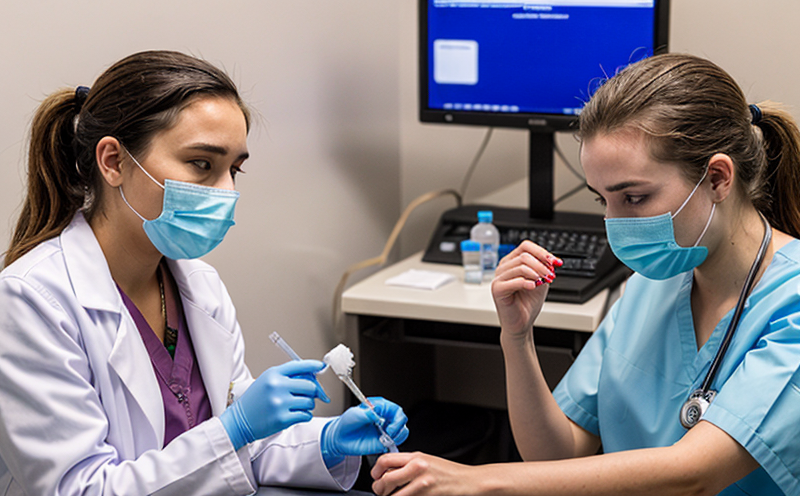ISO 15190 Clinical Laboratory Biosafety Testing
The ISO 15190 standard is a cornerstone in ensuring biosafety and quality assurance within clinical laboratories. This testing protocol is pivotal for the accurate, reliable, and safe performance of microbiological tests used to diagnose infectious diseases. Compliance with this standard helps protect both patients and laboratory workers from potential biohazards.
The scope of ISO 15190 includes not only the operational aspects but also the biosafety measures required in the design, installation, operation, and maintenance of clinical laboratories. It ensures that all procedures are conducted under controlled conditions to minimize risks associated with microorganisms.
One of the primary objectives of this standard is to establish a framework for managing biological agents used in diagnostic tests. This includes handling specimens, reagents, and other materials safely to prevent accidental exposure or contamination. The standard also addresses the training and proficiency of personnel involved in these processes.
The testing procedures outlined by ISO 15190 are designed to be robust yet flexible enough to accommodate various laboratory settings. From small community clinics to large academic medical centers, this standard provides a universal set of guidelines that can be tailored to meet specific operational needs. By adhering to these standards, laboratories enhance their reputation for reliability and safety.
Compliance with ISO 15190 is essential not only for regulatory reasons but also because it fosters trust among patients, healthcare providers, and the public. In today’s healthcare landscape, where transparency and accountability are paramount, adherence to this standard demonstrates a commitment to excellence in clinical microbiology testing.
Let's delve deeper into how ISO 15190 influences biosafety practices and quality assurance within clinical laboratories:
- Biosafety cabinets: Proper use and maintenance of these critical pieces of equipment are emphasized to ensure optimal protection against airborne pathogens.
- Personal protective equipment (PPE): Guidelines for selecting, wearing, and disposing of PPE are provided to safeguard laboratory staff from potential hazards.
- Contamination control: Procedures for preventing cross-contamination between samples are detailed to maintain the integrity of test results.
The standard also includes specific protocols for handling specimens such as blood cultures, sputum, and cerebrospinal fluid. These procedures cover everything from collection methods to storage conditions that ensure specimen stability and accuracy of test results.
Understanding the practical aspects of ISO 15190 is crucial for quality managers, compliance officers, R&D engineers, and procurement professionals who must oversee or implement these protocols in their respective roles. By familiarizing themselves with this standard, they can contribute to maintaining a safe and efficient laboratory environment.
Applied Standards
| Standard Reference | Description |
|---|---|
| ISO 15190:2016 | This standard provides comprehensive guidelines for biosafety in clinical laboratories. It covers all aspects from specimen handling to waste management, ensuring a safe working environment. |
| IEC 62366-4:2020 | A companion standard that focuses on the design and testing of medical devices used in microbiological diagnostics, which must comply with ISO 15190. |
The application of these standards ensures consistency across different laboratories and jurisdictions, facilitating international collaboration and mutual recognition. Compliance with these guidelines helps maintain high-quality diagnostic services while adhering to global best practices in biosafety.
Industry Applications
- Public health institutions: Ensuring that all diagnostic tests are conducted under safe conditions is crucial for preventing outbreaks and protecting public health.
- Hospitals: Compliance with ISO 15190 helps hospitals maintain accreditation and meet regulatory requirements, enhancing patient care.
- Pharmaceutical companies: Adherence to these standards ensures the quality of drug testing and clinical trials, contributing to safer treatments for patients.
| Application Area | Biosafety Measures |
|---|---|
| HIV Testing | Strict protocols are in place to prevent cross-contamination and ensure accurate results, which is vital for patient diagnosis. |
| Viral Load Monitoring | Biosafety cabinets and PPE are used extensively to minimize the risk of accidental exposure during sample handling and analysis. |
These applications underscore the importance of ISO 15190 in maintaining biosafety practices across various sectors. By implementing these standards, laboratories can contribute significantly to public health and patient safety.
Customer Impact and Satisfaction
- Patient confidence: Knowing that their samples are handled safely alleviates concerns about potential risks.
- Accurate diagnostics: Compliance with ISO 15190 ensures reliable test results, leading to more effective treatment plans.
- Regulatory compliance: Adherence to these standards helps laboratories meet regulatory requirements and avoid fines or penalties.
The impact of ISO 15190 extends beyond the laboratory itself; it also influences patient outcomes. By reducing errors and ensuring accurate diagnoses, this standard contributes to better health outcomes for individuals seeking medical care.
Customer satisfaction is enhanced when there are no delays or discrepancies in test results due to biosafety lapses. This not only improves the reputation of the laboratory but also fosters trust between healthcare providers and patients.





